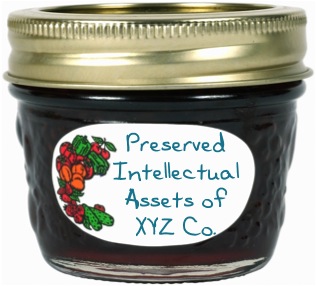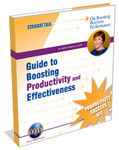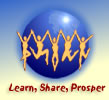 |
|
March 2019
Volume 15, Issue 3
These are free monthly tips on boosting
business and professional results.
Start your subscription!
To change subscription options, please
see the bottom of the page.
 Like us on Facebook! Like us on Facebook!
|
|
Greetings!
Below find this month’s newsletter, hot off the press!
Please add “Adele@LearnShareProsper.com” to your whitelist or address book in your e-mail program,
so that you have no trouble receiving future issues.
You subscribed to this newsletter at LearnShareProsper.com. You’re very welcome to forward it to your
colleagues; please just keep the entire message intact.
If you wish to discontinue your subscription, please
use the links at the bottom.
|
|
 |
|
Are You Preserving Your
Organization’s
Intellectual Assets?

In today’s issue, we continue exploring the timing, tools, and techniques for increasing the talents and effectiveness of your staff.
Should you train or use a different approach to close an achievement gap? And when you do train, how can you be sure the training will “stick” and become part of the organization’s intellectual knowledgebase?
My last newsletter introduced a concept called training transfer, which refers to the many conditions that should be satisfied before the learners can successfully apply new learning to their jobs. Since training produces a relatively short-lived result unless it is accompanied by plenty of support, it pays to plan carefully and follow through systematically!
Also consider that if significant turnover or downsizing occurs, it would mean that many of the company’s intellectual assets — people with precious, or even priceless skills and knowledge — would simply walk out the door, perhaps not ever to return. Can you afford the time and expense of seeking replacements?
Training may be one of the key ways you can expand organizational expertise and improve retention. For these reasons, I hope you enjoy today’s features (including Part 2 of this series on training). And please share your thoughts by leaving your comments on my Facebook page!
Here’s to your business prosperity,

Adele Sommers, Ph.D., business improvement specialist, author, educator, and award-winning instructional designer
P.S. If you missed any previous issue, please visit
the newsletter archive!
|
|
 |
|
How Proactive Are Your Training Policies?
If your organization invests in its personnel, it’s taking a far-sighted view of success. Continually identifying and tapping the talents of your teams while also increasing their expertise can help your company remain flexible, energized, and profitable. In so doing, you make “co-visionaries” of your staff by helping them:
- Turn their strongest aptitudes into their most valuable expertise
- Understand cause-and-effect relationships in the business, and
- Learn to use highly effective performance-building techniques
Don’t Depend on Luck!
 In good, plentiful times, it might seem very reasonable to “hire and forget,” either when gaining new employees or tapping contract help. In good, plentiful times, it might seem very reasonable to “hire and forget,” either when gaining new employees or tapping contract help.
With this approach, you would hire or contract someone to fulfill a particular need, apply a dollop of orientation and maybe a dab of training, send them into action, and presto! Problem solved!
Or is it?
You should recognize that the invaluable potential embodied in your personnel can best serve the company’s goals when everyone’s talents are nurtured. The key is to match people’s roles carefully to their aptitudes, and develop those talents along each individual’s greatest strengths. Those strengths are the intellectual capital that forms the indispensable backbone of the organization.
Companies sometimes fret about whether to invest in developing their personnel, since those same people might later leave with the skills, ideas, and knowledge they acquired on the job.
In rebuttal, I once heard Rick Barrera, the author of “Overpromise & Overdeliver: The_Secrets_of Unshakable Customer Loyalty,” reflect: “Some companies worry, ‘What if we train people, and they leave?’ The more important concern should be, ‘What if we don’t train people... and they stay?’”
Read on for another view of this important topic! |
|
 |
Tips on Making Training Stick (Part 2)
by Adele Sommers
 When your organization decides to undertake any type of training program, how can you make certain that employees will actually benefit from and apply what they’ve learned? When your organization decides to undertake any type of training program, how can you make certain that employees will actually benefit from and apply what they’ve learned?
After all, training is an expensive proposition that often produces fleeting results, so you certainly want to get the most from your investment.
In Part 1 of this series, I introduced management’s key role in supporting the many factors that determine how well people can transfer any training they receive to their jobs.
In review, there are many situations in which training might not be appropriate, such as when people already have the knowledge to do their jobs, but are being hampered by workplace obstacles. But when training is called for, learners must be able to apply the new knowledge in the workplace.
Part 1 of the series covered two of four vital steps for ensuring training transfer:
- Step 1: Determine Organizational Needs that Require Training
- Step 2: Carefully Plan the Instructional Experience
In Part 2, below, I’ll discuss the remaining two steps in the process.
Step 3: Identify Support Needs Related to Instruction
The purpose of this step is to describe how management plans to buttress the instructional experience in ways that will help employees use their new skills in actual work settings. This section builds on the supervisor’s commitments in the learning contract (see Part 1) by adding some important dimensions that only management can provide. In this step, here’s what management will want to do:
- List the types of support needed before, during, and after training.
For example, you might want to schedule fill-in personnel or postpone the completion of the employee’s assignments until after the training. If fill-in personnel will be used for desk coverage before, during, or after training, you'll want to identify, notify, and schedule them for those assignments.
- Identify situations in which practice and feedback can occur. Those situations could include staff meetings, presentations, team problem solving workshops, or one-on-one sessions. The learners could demonstrate and practice their newly acquired skills to receive feedback and suggestions.
- Initiate “relapse prevention” detection mechanisms and coaching. Applying new learning is by no means foolproof, and lapses are inevitable. To keep lapses from becoming total relapses to pre-instructional skill levels, these guidelines suggest how management can help learners prevent them:
Management Guidelines for Relapse Prevention
 Recognize lapses as useful information, not as failures. Recognize lapses as useful information, not as failures.
 Schedule role-playing or coaching sessions in advance to prevent lapses. Schedule role-playing or coaching sessions in advance to prevent lapses.
 Encourage trainees to record their successes when using skills on the job. Encourage trainees to record their successes when using skills on the job.
 Use just-in-time facilitation to help teams apply new skills to real projects. Use just-in-time facilitation to help teams apply new skills to real projects.
 Consider implementing an electronic support system where learners can return to refresh and maintain their skills. Ideally, the training program itself would be built around a practice environment with advisory knowledgebase. Consider implementing an electronic support system where learners can return to refresh and maintain their skills. Ideally, the training program itself would be built around a practice environment with advisory knowledgebase.
|
This next component relates to what specifically happens after the training occurs.
No later than very soon after the training, have each employee and supervisor or manager complete a training applications contract. In contrast to the learning contract, this agreement deals with how employees will apply their newly acquired skills to real work assignments. (Tip: Use a separate contract for each employee.)
TRAINING APPLICATIONS CONTRACT
Employee’s Commitment:
I, __________________________, plan to apply my training as follows:
- Maintaining and sharing my “ideas and applications notebook.”
- Periodically reviewing my ideas and/or action plan with my supervisor.
- Applying skills and knowledge from my instruction to the following tasks or projects:
a. _____________________________________________________
b. _____________________________________________________
c. _____________________________________________________
Signed________________________
Date__________________________
Supervisor’s (or Manager’s) Commitment:
I, ____________________, supervisor of the above employee, agree to set specific dates for support and encouragement of the job-related applications listed above. These dates are currently scheduled as follows:
Date #1 ____________________ Date #2 _____________________
Date #3 ____________________ Date #4 _____________________
Signed________________________
Date__________________________
Adapted from M. Broad & J. Newstrom (1992). Transfer of Training. |
Step 4: Identify Support Needs Related to the Work Environment
This final step pertains to how management can optimize the work setting to enable employees to effectively use their new skills. By creating an optimization plan to address the environmental factors below, you can better assure transfer success. In the plan, explain how you will make certain that the following occur:
- Aligned consequences: For reward and incentive systems to work well, they must align with improvement goals and give learners recognition for desirable achievement. Management also must remove any negative consequences that would inadvertently inhibit the use of new skills.
-
 Clear work documentation: Work policies, procedures, and processes should correlate closely with the training objectives to enable trainees to produce the required outcomes. Clear work documentation: Work policies, procedures, and processes should correlate closely with the training objectives to enable trainees to produce the required outcomes.
- Unambiguous work expectations: Beyond documented directives, management should clearly communicate job requirements to the trainees.
- Information, job aids, and resources: Effective training follow-up includes providing related information, reference aids, and the resources (including staff, budget, schedule, tools, and equipment) to help produce the desired results.
- Reduced complexity: Complexity in the job environment makes every aspect of the work more difficult — from documenting procedures to task completion. Instead, streamlining the work lessens cost, time, and effort, especially for trainees.
- Optimized workflows: Constraints in the workflow create bottlenecks that need careful management. When the workflow is cumbersome and constant interruptions occur due to inadequate prioritization, the ability to apply new skills suffers dramatically.
- Eliminated work obstacles: Productivity barriers can include anything from the issues listed above to confusing procedures to uncalibrated equipment to out-of-control processes that cause variability beyond the workers’ control. I described several of these in a prior article; many impede training transfer.
- Periodic progress reviews: In regularly scheduled sessions (such as at three-month intervals), you can gauge the extent to which people continue to apply their skills. These sessions could involve reviewing task checklists, evaluating work results, discussing any further practice options, identifying obstacles, and generating ideas for system improvements.
A summary of some of the instructional and environmental support possibilities appears below:
In conclusion, management’s diligent focus on supporting the transfer of training from a planning, instructional, and environmental perspective will help ensure that the valuable resources invested in training will produce the greatest possible benefit to the organization. Not only will relevant training enhance the value of a company’s intellectual assets, but it will also significantly boost the proficiency, morale, and retention of its personnel.
Copyright 2019 Adele Sommers
|
|
 |
|
“Guide to Boosting Productivity and Effectiveness”

Are you looking for a cookbook of great ideas for boosting your staff’s capabilities, eliminating hassles, streamlining procedures, and developing cutting-edge processes?
My Productivity
Success Kit offers a compendium of “how-to” techniques for increasing your organizational effectiveness.
This comprehensive special report includes 36 pages of tips, best practices, checklists, and worksheets that will help your business gain a potent competitive advantage! |
|
 |
|
Adele Sommers, Ph.D. is the author of “Straight
Talk on Boosting Business Performance” — an award-winning
Special Report and Workbook program.
If you liked today’s issue, you’ll love this down-to-earth
overview of how 12 potent business-boosting strategies
can reenergize the morale and productivity of your enterprise,
tame unruly projects, and attract loyal, satisfied customers.
It’s accompanied by a step-by-step workbook designed
to help you easily create your own success action plan.
Browse the table of contents and reader reviews on the
description page.
Adele also offers no-cost articles and resources to
help small businesses and large organizations accelerate
productivity and increase profitability. Learn more
at LearnShareProsper.com.
LearnShareProsper.com/Business Performance_Inc.,
705 North State Street #187, Ukiah, California,
USA.
For more information, e-mail Info@LearnShareProsper.com. |
|
|
|
| |
|
©2019
Business Performance_Inc., Adele Sommers, All rights
reserved. www.LearnShareProsper.com
Your feedback is always appreciated!
Write to us at info@LearnShareProsper.com.
We respect your privacy and do not give out or sell
subscriber names or e-mail addresses.
Please use the links below to take
yourself off our list or change your e-mail address.
|
|
|


